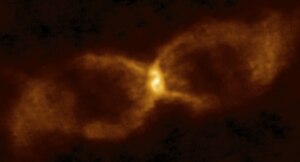
Alpha Vulpeculae, officially named Anser, is the brightest star in the constellation of Vulpecula. It is approximately 291 light-years from Earth. It forms a wide optical binary with 8 Vulpeculae.

NQ Vulpeculae also known as Nova Vulpeculae 1976, was a nova that appeared in the constellation Vulpecula in 1976. It was discovered visually at 18:20 UT on October 21, 1976 by English amateur astronomer George Alcock. Its apparent magnitude at the time of discovery was 6.5 It reached its maximum brightness of magnitude 6.0 thirteen days after its discovery, at which point it may have been faintly visible to the naked eye. A few days after maximum brightness, it had faded to magnitude 8.3.
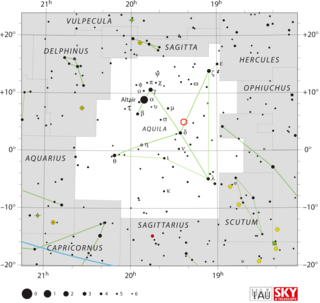
V1494 Aquilae or Nova Aquilae 1999 b was a nova which occurred during 1999 in the constellation Aquila and reached a brightness of magnitude 3.9 on 2 December 1999. making it easily visible to the naked eye. The nova was discovered with 14×100 binoculars by Alfredo Pereira of Cabo da Roca, Portugal at 18:50 UT on 1 December 1999, when it had a visual magnitude of 6.0.
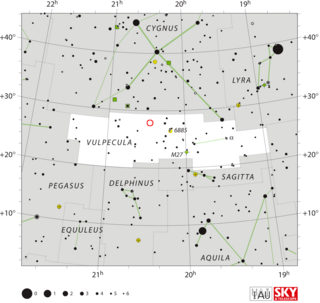
QU Vulpeculae, also known as Nova Vulpeculae 1984 Number 2, was the second nova which occurred in 1984 in the constellation Vulpecula. It was discovered by Peter Collins, an amateur astronomer from Cardiff, California at 22:08 UT on 22 December 1984. At the time of its discovery, the nova's apparent magnitude was 6.8. By the next night, Collins reported its brightness had increased to magnitude 5.6, making it visible to the naked eye.
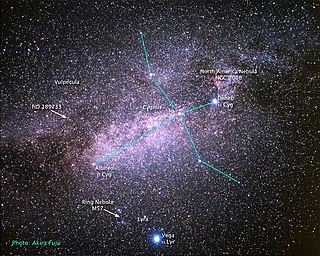
HD 189733, also catalogued as V452 Vulpeculae, is a binary star system 64.5 light-years away in the constellation of Vulpecula. The primary star is suspected to be an orange dwarf star, while the secondary star is a red dwarf star. Given that this system has the same visual magnitude as HD 209458, it promises much for the study of close transiting extrasolar planets. The star can be found with binoculars 0.3 degrees east of the Dumbbell Nebula (M27).

Sakurai's Object is a star in the constellation of Sagittarius. It is thought to have previously been a white dwarf that, as a result of a very late thermal pulse, swelled and became a red giant. It is located at the center of a planetary nebula and is believed to currently be in thermal instability and within its final shell helium flash phase.

13 Vulpeculae is a blue giant with a stellar classification of class B9.5III in the northern constellation Vulpecula. It is visible to the naked eye as a faint, blue-white hued star with an apparent visual magnitude of 4.57 and it is approximately 339 light years away from the Sun based on parallax. The star is radiating 180 times the luminosity of the Sun from its photosphere at an effective temperature of 8,801 K.

15 Vulpeculae is a variable star in the northern constellation of Vulpecula, located approximately 243 light years away based on parallax. It has the variable star designation NT Vulpeculae; 15 Vulpeculae is the Flamsteed designation. It is visible to the naked eye as a faint, white-hued star with a typical apparent visual magnitude of 4.66. This object is moving closer to the Earth with a heliocentric radial velocity of −26 km/s.

12 Vulpeculae is a star in the northern constellation of Vulpecula, located approximately 630 light years away based on parallax. It has the variable star designation V395 Vul; 12 Vulpeculae is the Flamsteed designation. This object is visible to the naked eye as a faint, blue-white hued star with a baseline apparent visual magnitude of 4.928. It is moving closer to the Earth with a heliocentric radial velocity of -25 km/s.

3 Vulpeculae is a binary star system in the northern constellation of Vulpecula, located around 366 light years away from the Sun. 3 Vulpeculae is its Flamsteed designation. It is visible to the naked eye as a faint, blue-white hued star with a baseline apparent visual magnitude of 5.18.
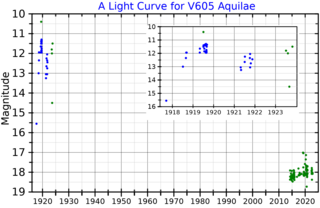
V605 Aquilae, in the constellation Aquila, is the variable central star of the planetary nebula Abell 58. It is a highly unusual hydrogen-deficient carbon-rich star.
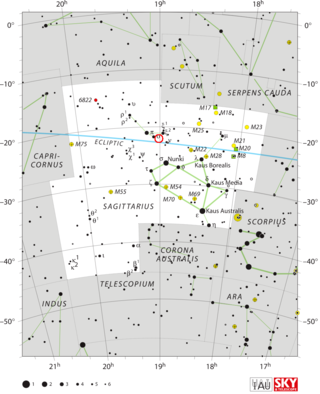
V4743 Sagittarii was a bright nova in the southern constellation of Sagittarius. This event was discovered by K. Haseda and colleagues in September 2002. It peaked at magnitude 5.0 on September 20, 2002, then declined rapidly thereafter. It reached a peak temperature of 740,000 K around April 2003 and remained at that level for at least five months, suggesting the white dwarf component has a mass of 1.1–1.2 M☉. The distance to this system is uncertain. Infrared observations indicate a distance of approximately 21 kly (6.3 kpc). A derivation using maximum magnitude rate of decay showed a distance of 12.7 ± 1.0 kly (3.9 ± 0.3 kpc).
V1309 Scorpii is a contact binary that merged into a single star in 2008 in a process known as a luminous red nova. It was the first star to provide conclusive evidence that contact binary systems end their evolution in a stellar merger. Its similarities to V838 Monocerotis and V4332 Sagittarii allowed scientists to identify these stars as merged contact binaries as well.
An Intermediate Luminosity Optical Transient (ILOT) is an astronomical object which undergoes an optically detectable explosive event with an absolute magnitude (M) brighter than a classical nova (M ~ −8) but fainter than that of a supernova (M ~ −17). That nine magnitude range corresponds to a factor of nearly 4000 in luminosity, so the ILOT class may include a wide variety of objects. The term ILOT first appeared in a 2009 paper discussing the nova-like event NGC 300 OT2008-1. As the term has gained more widespread use, it has begun to be applied to some objects like KjPn 8 and CK Vulpeculae for which no transient event has been observed, but which may have been dramatically affected by an ILOT event in the past. The number of ILOTs known is expected to increase substantially when the Vera C. Rubin Observatory becomes operational.
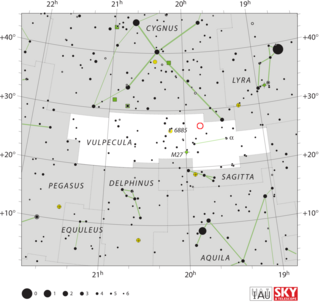
LV Vulpeculae, also known as Nova Vulpeculae 1968 no. 1, was the first of two novae in the constellation of Vulpecula which erupted in 1968. It was discovered by George Alcock who observed it from the back garden of his home in Farcet, England, on the morning of 15 April 1968. The next night it was independently discovered by Midtskoven in Norway. It reached a peak apparent magnitude of 4.79 on 17 April 1968. It was visible to the naked eye at the same time HR Delphini was a naked eye object, and the two novae were less than 15 degrees apart on the sky.

WY Sagittae, also known as Nova Sagittae 1783, is a star in the constellation Sagitta which had a nova eruption visible in 1783. It was discovered on 26 July 1783 by the French astronomer Joseph Lepaute D'Agelet. It is usually difficult to precisely identify novae that were discovered hundreds of years ago, because the positions were often vaguely reported and historically there was not a clear distinction drawn between different sorts of transient astronomical events such as novae and comet apparitions. However D'Agelet observed this nova with a mural quadrant, which produced coordinates accurate enough to allow modern astronomers to identify the star. D'Agelet reported the apparent magnitude of the star as 6, but Benjamin Apthorp Gould, who analysed D'Agelet's records, determined that what D'Agelet called magnitude 6 corresponds to magnitude 5.4 ± 0.4 on the modern magnitude scale, so the nova was visible to the naked eye.

V1370 Aquilae, also known as Nova Aquilae 1982, is a nova that appeared in the constellation Aquila during 1982. It was discovered by Minoru Honda of Kurashiki, Japan at 20:30 UT on 27 January 1982. At that time the Sun had moved just far enough from Aquila to allow the nova to be seen in the morning sky. Although it was discovered photographically, its apparent magnitude was 6–7, making it potentially visible to the naked eye under ideal conditions. A possible magnitude 20 progenitor was located on the Palomar Sky Survey prints. Spectra of the object were taken in February 1982 at Asiago Astrophysical Observatory, which confirmed that it is a nova.

IRAS 00500+6713 is the catalogued infrared source for an unusual nebula in Cassiopeia, while the central star has a designation WD J005311, with the whole system designated as Pa 30. The central star and its surrounding shell were created by the supernova seen in the year 1181 as reported by Chinese and Japanese observers. Both the nebula and central star have unique and extreme properties, pointing to their creation by a rare type Iax supernova, where two ultra-dense white dwarfs in-spiral to a collision and explosion. The Pa 30 system was discovered in 2013 by amateur astronomer Dana Patchick, the extreme properties of the central star were first seen in 2019 by Gvaramadze and colleagues, and they recognized that the system was created in a low-luminosity supernova event from a merger of two white dwarfs.

PU Vulpeculae is a very slowly evolving symbiotic nova in the northern constellation of Vulpecula, abbreviated PU Vul. It is too faint to be visible to the naked eye, reaching a maximum apparent visual magnitude of 8.7 following a minimum of 16.6. The system is located at a distance of approximately 17,000 light years from the Sun based on parallax measurements.

QQ Vulpeculae is a cataclysmic variable binary star system in the northern constellation of Vulpecula, abbreviated QQ Vul. It has a brightness that fluctuates around an apparent visual magnitude of 14.7, which is too faint to be viewed with the naked eye. The distance to this system is approximately 981 light years based on parallax measurements.
